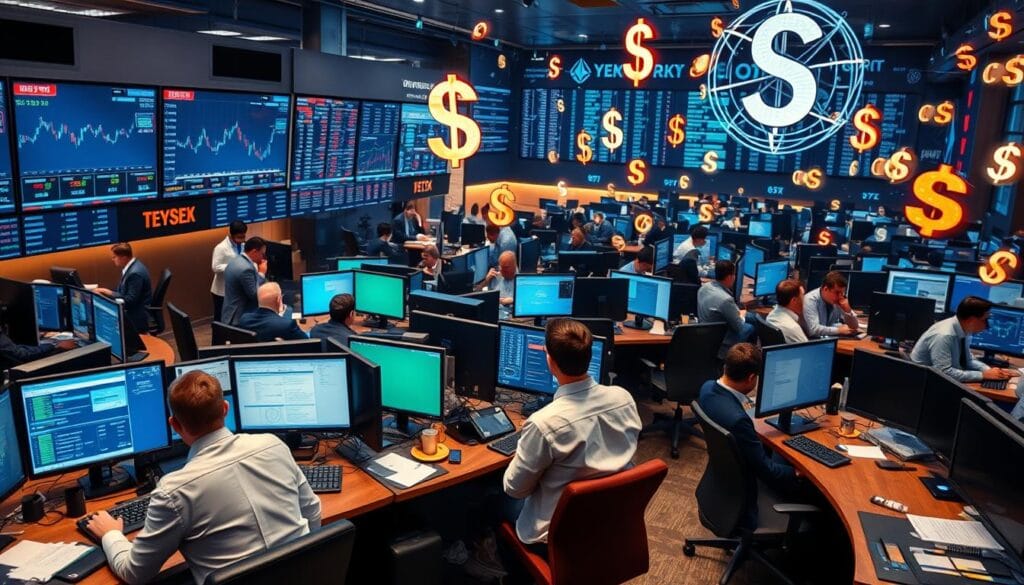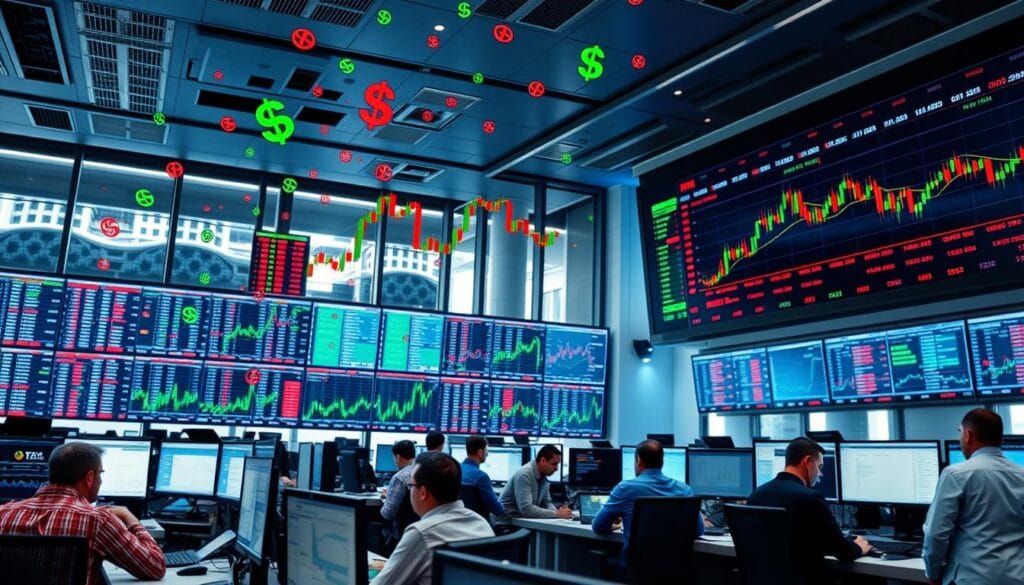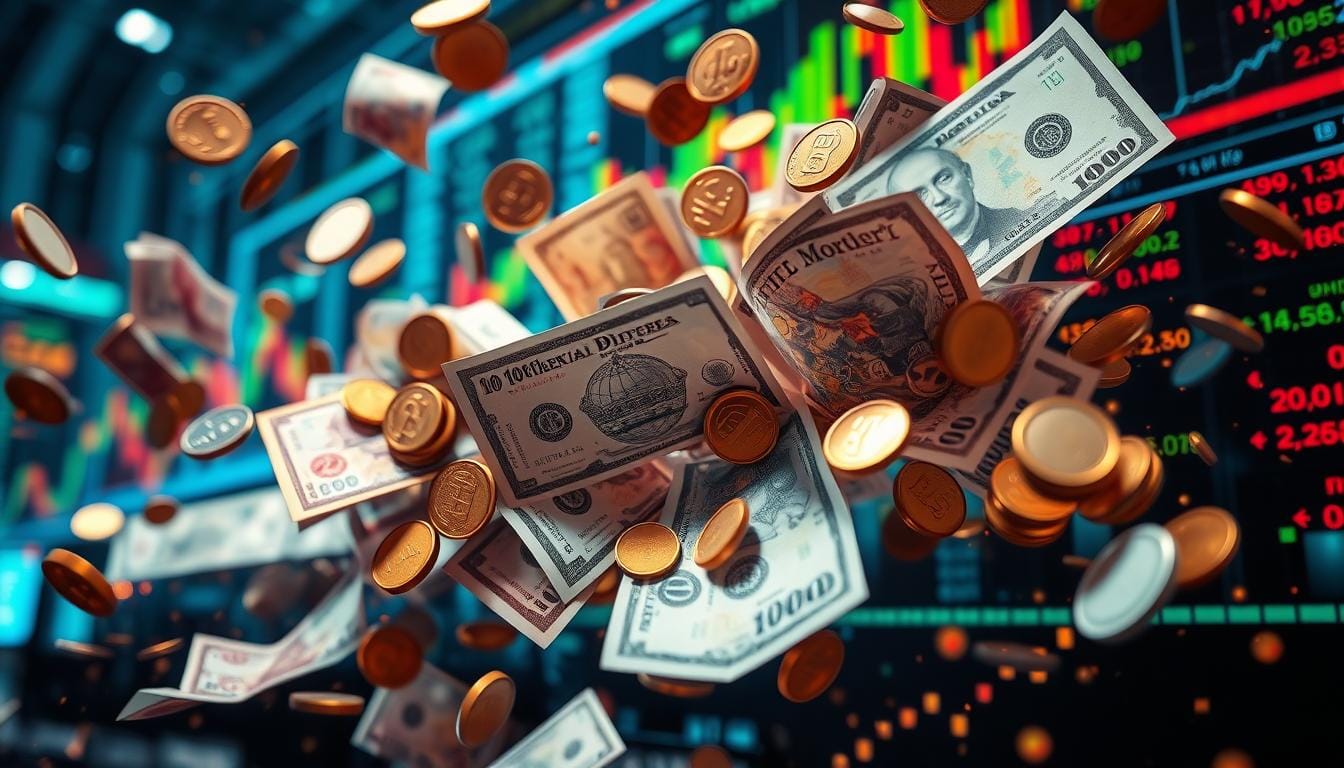שוק ה-forex הוא המקום בו מתבצעת סחר במטבעות גלובליים. זהו נוף פיננסי עצום ודינמי. מאמר זה חוקר איך שוק ה-forex פועל ואת המושגים העיקריים שלו.
נבחן את השחקנים העיקריים ואת האסטרטגיות ב-המרת מטבע. תלמד מה משפיע על שערי ההמרה וכיצד סוחרים מצליחים פועלים.
מסקנות עיקריות
- המרת מטבע היא המסחר במטבע אחד בתמורה למטבע אחר, עם המטרה להרוויח משינויים ב-שערי ההמרה.
- שוק ה-forex הוא השוק הגדול ביותר והמנוזל ביותר בעולם, עם נפח מסחר יומי של מעל 6 טריליון דולר.
- זוגות מטבע עיקריים, כגון EUR/USD ו-USD/JPY, הם הנסחרים ביותר והמבוקרים בצורה הכי קרובה בשוק ה-forex.
- גורמים כמו ריבית, ביצועים כלכליים ויציבות פוליטית משפיעים באופן משמעותי על תנועות בשערי ההמרה.
- סוחרי forex מצליחים משתמשים בשילוב של ניתוח יסודי וטכני כדי לזהות הזדמנויות מסחר ולנהל סיכונים בצורה יעילה.
מהו סחר במטבע וסחר בפורקס?
סחר במטבע הוא החלפת מטבע אחד במטבע אחר. זה חשוב לפיננסים גלובליים ומאפשר עסקאות בינלאומיות. סחר בפורקס כולל המרת מטבעות בהתבסס על שערי חליפין.
הגדרה ויסודות של סחר במטבע
הגדרת סחר בפורקס אומרת קנייה ומכירת מטבעות כדי להרוויח משינויים בשערים. סוחרים משקיעים בהערכת ערכי מטבע בשוק זה. שוק הפורקס עצום, עם טריליונים נסחרים בכל יום.
זוגות מטבע עיקריים וחשיבותם
ב-זוגות מטבע עיקריים, הדולר האמריקאי מתאים עם מטבעות עליונים אחרים. אלו כוללים את היורו, הין היפני, הלירה הבריטית והפרנק השוויצרי. אלו "עיקריים" הם הזוגות הנסחרים ביותר.
שינויים בשערי הזוגות הללו משפיעים על מסחר וכלכלה גלובליים. הם חיוניים לעסקים והשקעות בינלאומיים.
| זוג מטבעות | תיאור |
|---|---|
| EUR/USD | הזוג הנסחר ביותר, המייצג את ערך היורו לעומת הדולר האמריקני. |
| USD/JPY | הזוג השני בסדר הנסחרים, המשקף את שער החליפין בין הדולר האמריקני לין היפני. |
| GBP/USD | הזוג השלישי בסדר הנסחרים, נקרא "כבל", המייצג את הלירה הבריטית לעומת הדולר האמריקני. |
להבין יסודות תמריץ מטבע ו-זוגות מטבע עיקריים חיוני עבור מסחר בפורקס. סוחרים חייבים לעקוב אחר הגורמים שמשפיעים על שערים כדי לקבל החלטות חכמות. הידע הזה עוזר לנהל סיכונים בעולם הפורקס המהיר.
שערי חליפין: גורמים ומקביעים
שערי חליפין חיוניים עבור מסחר בפורקס. הם מראים את הערך של מטבע אחד בהשוואה למטבע אחר. הרבה גורמים עשויים לגרום לשינויים מהירים בשערים אלה.
ריבית משפיעה מאוד על שערי חליפין. שערים גבוהים יכולים להפוך מטבעות למשתלמים יותר. משקיעים רוצים החזרים טובים יותר על הכסף שלהם.
אינפלציה היא גורם נוסף חשוב. מדינות עם אינפלציה גבוהה רגיל לראות את מטבעותיהן מאבדים ערך. זה קורה בהשוואה למדינות עם אינפלציה נמוכה.
צמיחה כלכלית ו-מוצר גופי פנימי (מג"פ) חשובים גם. מדינות חזקות מושיכות יותר משקיעים. זה עשוי להפוך את מטבעותיהן לשווים יותר.
אירועים פוליטיים וגיאופוליטיים עשויים לזעוזע את שערי החליפין. בחירות, חוקים חדשים או סכסוכים משנים את דרך הראייה של האנשים על מטבעות. אלה האירועים עשויים לגרום לשינויים גדולים בערך.
רגשות המשקיעים וטרנדים בשוק גם משפיעים. איך אנשים מרגישים לגבי מטבע יכול לשנות את ערכו במהירות.
| גורמים המשפיעים על שערי חליפין | תיאור |
|---|---|
| ריבית | מטבעות עם ריבית גבוהה נוטים להעריך בערך בהשוואה לאלה עם ריבית נמוכה, מאחר שמשקיעים מחפשים תשואות גבוהות יותר. |
| אינפלציה | מטבעות ממדינות עם שערי אינפלציה גבוהים נטים להדיל מול אלה ממדינות עם אינפלציה נמוכה. |
| צמיחה כלכלית ותמ"ג | מטבעות ממדינות עם ביצוע כלכלי חזק וצמיחה טובה נוטים להיות יותר מושכים למשקיעים, מה שמביא להערכת ערכם. |
| אירועים פוליטיים וגיאופוליטיים | אירועים כגון בחירות, שינויי מדיניות, או סכסוכים בינלאומיים עשויים להשפיע באופן משמעותי על הביקוש למטבע, גורמים לו להתנדנד בערך. |
| תחושת המשקיע ופסיכולוגית השוק | התחושה הכללית והפסיכולוגיה של משתתפי השוק יכולות גם לתרום לטבעם הדינמי של שערי החליפין. |
לדעת את הגורמים והמכריעים הללו עוזר לסוחרי הפורקס לקבל החלטות חכמות יותר. הם יכולים לחזות בצורה טובה יותר שינויים בשוק ולשפר את האסטרטגיות שלהם.

שוק הפורקס: נפילים ומשתתפים עיקריים
שוק הפורקס הוא אקוסיסטם רחב עם משתתפים מגוונים. חשוב להבין את הנפילים העיקריים והתפקידים שלהם. בנקים מרכזיים ובנקים מסחריים משפיעים באופן משמעותי על שערי חליפין.
בנקים מרכזיים ומדיניות מוניטרית
בנקים מרכזיים, כמו מערכת הריזרבה הפדרלית, הם נפילים עיקריים בשוק הפורקס. הם מיישמים מדיניות כדי לשמור על יציבות כלכלית ולנהל את האינפלציה. החלטותיהם בנושא ריבית יכולות להשפיע מאוד על ערכי מטבע.
על ידי כוונון מדיניות, בנקים מרכזיים משפיעים על הצעת וביקוש של מטבעות. סוחרי הפורקס עוקבים בקרוב אחר פעולות הבנק המרכזי. אלו עשויים לגרום לשינויים משמעותיים במחירי מטבעות.
בנקים מסחריים ומשקיעים מוסדיים
בנקים מסחריים משתתפים בפעילות מסחר במט"ח. הם מקלים על מסחר בינלאומי וניהול חשיפות למטבע. כאלה הבנקים נוהגים לפעול כאמצעי בין סוחרים פרטיים לשוק הגדול יותר.
משקיעים מוסדיים גם משחקים תפקיד חשוב בשוק המט"ח. הם משתמשים במסחר במט"ח כדי להפיץ תיקי השקעות ולהגן על סיכונים. נפחי המסחר הגדולים שלהם יכולים להשפיע מאוד על מחירי המטבע.
| משתתפים מרכזיים בשוק הפורקס | תפקיד והשפעה |
|---|---|
| בנקי מרכז | מיישמים מדיניות מוניטרית לניהול יציבות כלכלית ואינפלציה, המשפיעה על ערכי מטבע |
| בנקים מסחריים | מקלים על סחר בינלאומי, ניהול חשיפות מטבע שלהם, ומספקים שירותים ללקוחות |
| משקיעים מוסדיים | משתמשים במסחר במטבע להתפשטות תיק השקעות, הגנת סיכונים, וספקולציה |
שוק ה-forex דינמי, עם מספר רב של נפגעים שמצטברים את שערי החליפין. בנקים מרכזיים, בנקים מסחריים ומשקיעים מוסדיים כולם משחקים תפקידים קריטיים. הבנת ההשפעה שלהם עוזרת לנו לנווט בעולם המורכב של תמריצי המטבעות הגלובליים.

המרת מטבע: אסטרטגיות וטכניקות מסחר
מסחר ב-forex מציע שיטות שונות להצלחה בשווקי המטבעות. שתי גישות עיקריות הן ניתוח יסודי וניתוח טכני. שיטות אלו עוזרות למשקיעים לנווט בעולם הדינמי של מסחר ב-forex.
ניתוח יסודי במסחר ב-forex
אסטרטגיות מסחר ב-forex באמצעות ניתוח יסודי בודקות גורמים כלכליים, פוליטיים וחברתיים. גישה זו חוקרת אינדיקטורים מקרו-כלכליים כמו תמות התמ"ג, שערי האינפלציה ומדיניות שעות הריבית. זה עוזר לסוחרים להבין כוח וחולשת מטבעות.
סוחרים יכולים לזהות מטבעות שנמצאים בערך נמוך או גבוה באמצעות השיטה הזו. זה שימושי למסחר לטווח ארוך ולהבנת כוחות השוק. ניתוח יסודות מסייע בקבלת החלטות מושכלות לגבי כניסה ויציאה מהשוק.
ניתוח טכני ותבניות בתרשימים
ניתוח טכני בשוק המט"ח חוקר תבניות מחירים היסטוריות וצורות בתרשימים. סוחרים מביטים ברמות תמיכה והתנגדות, קווי מגמה ותבניות של נרות. זה עוזר להם לזהות הזדמנויות מסחר אפשריות.
אינדיקטורים טכניים עוזרים לזהות נקודות כניסה ויציאה, מגמות והיפוך טפסים. השיטה הזו פופולרית למסחר לטווח קצר. זה מאפשר לסוחרים להשיג רווחים מהשתנויות בשוק המטבעות.
| ניתוח בסיסי | ניתוח טכני |
|---|---|
| מתמקד בגורמים כלכליים, פוליטיים וחברתיים | מתמקד בתבניות מחיר היסטוריות וצורות תרשימים |
| שימושי למסחר לטווח ארוך ולהבנת כוחות השוק | שימושי למסחר לטווח קצר ולזיהוי נקודות כניסה/יציאה פוטנציאליות |
| עוזר לזהות מטבעות שנמצאים בערך נמוך או גבוה | עוזר לזהות מגמות עולמות והיפוך פוטנציאלי |
שילוב ניתוח יסודי בפורקס ו-ניתוח טכני בפורקס יוצר גישה מאוזנת. האסטרטגיה הזו עוזרת לסוחרים לנווט בשווקי מטבע ולהגביר את הסיכויים שלהם להצלחה.

"במסחר במטבעות, הצלחה מתקבלת מהשלבה של ניתוח יסודי וטכני. זה מאפשר לסוחרים לקבל החלטות חכמות ולהשתלט על הזדמנויות בשוק."
ניהול סיכון במסחר במטבעות
ניהול סיכון יעיל הוא מפתח להצלחה במסחר במטבעות. שוק הפורקס הוא דינמי וסוער. הבנת שימוש בהשקעה ובדרישות שוליים עוזרת לסוחרים לנווט בסיכונים ולהשיג הצלחה בר-תוקף.
הבנת שימוש בהשקעה ובדרישות שוליים
שימוש בהשקעה מאפשר לסוחרים לשלוט בעמדות גדולות עם הון קטן. זה יכול להגביר רווחים אך גם להגביר הפסדים. סוחרי פורקס חייבים להבין כיצד השקעה משפיעה על עמדות המסחר שלהם.
דרישות השוליים קובעות את ההון הנדרש כדי לשמור על עמדות פתוחות. הבנת דרישות אלו חיונית כדי למנוע נזילת סחורות לא רצויה.
אסטרטגיות ניהול סיכון נבונות יכולות לעזור להפחית את הסיכון בהשקעה ובשוליים. אלו כוללות קביעת הזמנות לעצירת הפסד והנפצת תיקי מסחר. יישום עקרונות ניהול כסף תקין חיוני גם כן.
איזון בין סיכון לתמורה חיוני במסחר בפורקס. הגישה הזו עוזרת לסוחרים לנווט בשוק בביטחון. זה גם מגביר את הסיכויים שלהם להצלחה לטווח ארוך.










